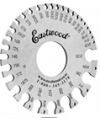weo
Basic Member
- Joined
- Sep 21, 2014
- Messages
- 3,097
(reading post #29 first will clear up any confusion as you read this thread)
Hello all. I hope I'm not beating a dead horse, so to speak, but couldn't find an answer in a search. Also, I feel I need to add some background for my question, so feel free to skip to the end of the post, where the question is.
Seeing as how all my forging equipment is in storage, I thought I'd focus my time in 'perfecting' my sharpening technique. Also, I'm hoping to land a job teaching blacksmithing soon, and I have a feeling they are going to want me to teach knife making as well, so I thought I should have a consistent system in place.
When I was taught how to make/finish a knife by an ABS Master smith, his technique for final edge grinding was to hold the blade parallel to the platen, but using the slack portion of the belt between the top wheel and the platen to get roughly a 10-15 degree (my understanding, not his exact words) primary bevel, then hand finish the edge on water stones.
Up to this point in my knife making career, I haven't been able to do this every day, so I don't yet have the muscle memory to keep a consistent edge angle every pass, so I came up with this as a guide:

Also, up to this point, I have been primarily interested in kitchen cutlery and haven't been too concerned with primary and secondary bevels, but doing a full flat grind getting as thin as practical then sharpening using one bevel. My current system is to establish the bevel as I was taught using a used 400g belt on the grinder, then using 800g-1200g-2000g Japanese water stone progression, finally leather strop with buffing compound to finish the edge.
In researching 'optimal' edge design on hunters/choppers/EDC knives/etc I'm learning the importance of paying attention to primary and secondary bevels.
My question(s): Do you professionals:
(a) use the grinder to establish both primary and secondary bevels, then repeat the process on stones,
(b) use the grinder to establish just the primary bevel, then refine the primary bevel on the stones, then repeat the stone progression for the secondary bevel,
(c) use just the stones to establish both bevels (which would mean adding a rougher grit stone), or
(d) something else?
Thank you and have a good rest of the summer (or winter for those of you in the Southern Hemisphere)
Hello all. I hope I'm not beating a dead horse, so to speak, but couldn't find an answer in a search. Also, I feel I need to add some background for my question, so feel free to skip to the end of the post, where the question is.
Seeing as how all my forging equipment is in storage, I thought I'd focus my time in 'perfecting' my sharpening technique. Also, I'm hoping to land a job teaching blacksmithing soon, and I have a feeling they are going to want me to teach knife making as well, so I thought I should have a consistent system in place.
When I was taught how to make/finish a knife by an ABS Master smith, his technique for final edge grinding was to hold the blade parallel to the platen, but using the slack portion of the belt between the top wheel and the platen to get roughly a 10-15 degree (my understanding, not his exact words) primary bevel, then hand finish the edge on water stones.
Up to this point in my knife making career, I haven't been able to do this every day, so I don't yet have the muscle memory to keep a consistent edge angle every pass, so I came up with this as a guide:

Also, up to this point, I have been primarily interested in kitchen cutlery and haven't been too concerned with primary and secondary bevels, but doing a full flat grind getting as thin as practical then sharpening using one bevel. My current system is to establish the bevel as I was taught using a used 400g belt on the grinder, then using 800g-1200g-2000g Japanese water stone progression, finally leather strop with buffing compound to finish the edge.
In researching 'optimal' edge design on hunters/choppers/EDC knives/etc I'm learning the importance of paying attention to primary and secondary bevels.
My question(s): Do you professionals:
(a) use the grinder to establish both primary and secondary bevels, then repeat the process on stones,
(b) use the grinder to establish just the primary bevel, then refine the primary bevel on the stones, then repeat the stone progression for the secondary bevel,
(c) use just the stones to establish both bevels (which would mean adding a rougher grit stone), or
(d) something else?
Thank you and have a good rest of the summer (or winter for those of you in the Southern Hemisphere)
Last edited:



